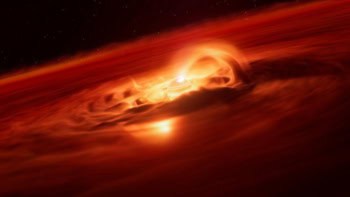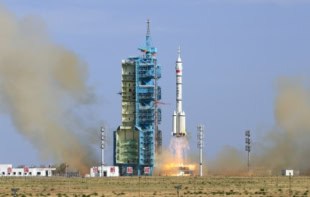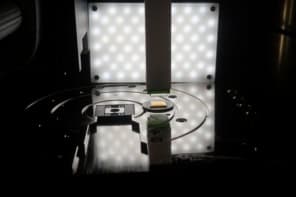
The slow darkening of the surface of rocky objects in space may be caused by the bombardment of particles in the solar wind. This is the conclusion of a new study by researchers in the US, who have simulated the effects of the solar wind by bombarding samples of rock with hydrogen and helium ions.
Physical and chemical weathering has a profound influence on the surface of the Earth, and it turns out that weathering also occurs on the surfaces of bodies in space. Space-weathering processes may have a variety of causes, including meteorite and micrometeorite impacts, cosmic rays, ultraviolet radiation and exposure to the solar wind.
Prolonged space weathering has a curious effect. The surfaces of weathered, airless bodies – like the Moon, Mercury and asteroids – gradually become darker and redder over time. Seen in lunar samples, this colouration appears to be caused by the formation at the surface of tiny particles of iron with grain sizes less than 50 nm. Exactly how these tiny iron particles form, however, has been the subject of much debate. One popular theory is the vaporization and recondensation of solid material caused by micrometeorite impacts. However, it is unclear how such a process could operate on small bodies, which experience lower-impact speeds.
Wind worn
In a new study, Kimberly Kuhlman of the Planetary Science Institute in Arizona and colleagues at the University of Wisconsin-Madison have instead explored whether the iron particles could be created by exposure to the solar wind – charged particles that stream from the Sun at speeds of several hundred kilometres per second. The team studied the effects of such charged particles on enstatite, which is a magnesium-rich orthopyroxene mineral that is common in the solar system. It is often found in meteorites and is abundant in the Earth’s mantle.
Kuhlman and colleagues began with wafers of enstatite – approximately 1 cm in diameter – that were highly polished and mounted on a larger slice of silicon. The samples were then bombarded with energetic hydrogen and helium ions using plasma-source ion implantation. This involves placing the target samples within a vacuum chamber, through which hydrogen and helium gas is allowed to flow. The gases are ionized by tungsten filaments and high-voltage pulses are used to accelerate the ions into the samples at energies comparable to the solar wind.
Following the bombardment, the researchers looked for changes to the composition of the outer 20 nm of the samples using scanning transmission electron microscopy. Sure enough, Kuhlman and colleagues found that the simulated solar wind caused the formation of iron nanoparticles.
Broken bonds
The researchers believe that the nanoparticles form because ion implantation disrupts the atomic lattice of the mineral, creating broken bonds. These are free to react with hydrogen, creating molecules of water and hydroxide. These molecules then escape the damaged lattice, leaving behind iron in a chemically reduced state. The iron then nucleates into nanoparticles.
“This continuing work will allow us to estimate the rate at which these nanophase iron particles form as a consequence of exposure to the solar wind,” says Kuhlman. She says that this information will help scientists to use remote sensing to infer the age of objects in the solar system, which in turn will inform our understanding of a wide range of physical processes that occur in space.
Simone Marchi of the Southwest Research Institute, who was not involved in this work, says that the study suggest that the solar wind is the best candidate for explaining nanophase iron formation in asteroids, outweighing the effects of micrometeorite impacts. Marchi adds, however, that other important aspects, such as the timescale involved in the formation of small iron particles, remain to be investigated in detail.
Cateline Lantz – an astrophysicist at the Observatoire de Paris – told physicsworld.com that the research is important because it has the potential to broaden our understanding of space weathering. “Space weathering is now well understood on the Moon and some asteroid types, but the dark primitive surfaces are still puzzling,” she says.
The research is described in Planetary and Space Science.



